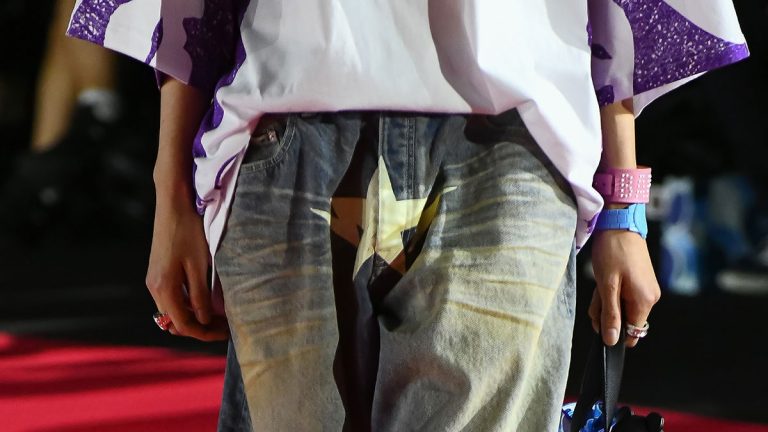“Labels like Fubu, Billionaire Boys Club and Icecream did a lot of branding in that kind of way,” says Rob Nowill, fashion editor and former content director at Mr Porter. “Then, you had Evisu doing huge branding across the rear of denim and sweatpants.”
The resurgence of this Y2K design staple arguably owes as much to one contemporary brand as it does to labels from the golden age of streetwear. Besides a brief renaissance via Pyrex and Hood By Air in the early 2010s, the groin graphic lay relatively dormant for a couple of decades. “Until Corteiz revived it, reintroducing it as their own,” says Luke Hodson, founder of youth marketing agency Nerds Collective.
The London-based label was launched in 2017, and by 2022 had become the most-hyped brand in streetwear. It now boasts celebrity fans like Drake, Stormzy and Skepta, collaborations with industry giants such as Supreme and Nike, and a ravenous fan base of mostly men aged anywhere from 13 to 30. It also regularly releases new colourways of one particularly recognisable group of products: shorts and joggers with the brand’s signature Alcatraz logo screen-printed across the crotch. To date, “Corteiz jogger” and “Corteiz shorts” are mentioned in 3.5 million and 5.1 million videos on TikTok, respectively.
While some modern designers are undoubtedly pulling inspiration from the early-noughties originators, Corteiz’s cultural influence has “led to a wave of imitations in both streetwear and fast fashion”, says Hodson.
By extension, says Luke Raymond, senior menswear lead at Flannels, “As the style has become more familiar, with more brands producing crotch print styles at mostly mid and mass market, demand has inevitably increased.”
Some commentators suggest that the flurry of brands that have moved in to meet that demand aren’t exactly adding much value. “There were originally brands playing on that Y2K idea in quite an interesting way, and now that’s trickled down to brands doing it quite derivatively,” says Nowill. Stylist Jake Hunte agrees: “The fast fashion brands, they’re just capitalising off of street culture.”
There’s another potential explanation for the rise of the crotch logo. “Logo T-shirts and hoodies drove businesses for years, but that’s slowed down,” says Nowill, referring to menswear in particular. “So this strikes me as brands looking for any remaining real estate on which to slap a logo or a piece of branding.” This is evident at the higher end of the market, where luxury labels are not only printing logos and graphics on crotches, but also adding branding details to hemlines, cuffs, and the knees and shins of denim, like Celine’s track pants or Loewe’s jeans.


